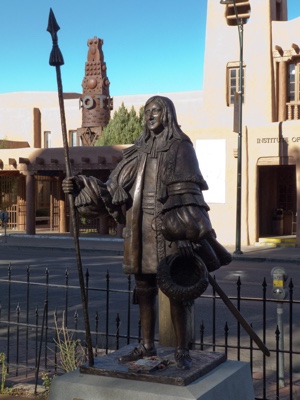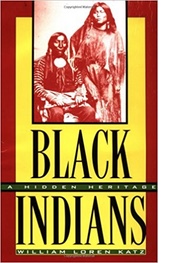In 1956 They Built a Statue in Santa Fe to Commemorate the Pueblo Revolt of 1680.

Photo: René & Peter van der Krogt, http://statues.vanderkrogt.net.
Last Sunday’s New York Times front page carried a story about a statue that honored New Mexico’s Spanish “founder” and discussing the Pueblo Revolt of 1680.
When I visited Santa Fe a decade earlier I came upon a statue relating to the Pueblo Revolt of 1680 by honoring the conquistador who suppressed it. This was my response.
 During
a May 2009 visit
to Santa Fe, which was eagerly preparing to celebrate its four
hundredth anniversary, I met the official planners of the event. I
also met with the executive board of the NAACP and representatives of
Native American cultural organizations. I learned that the white
organizers were planning a celebration when local people of color
persuaded them it should also be a commemoration.
During
a May 2009 visit
to Santa Fe, which was eagerly preparing to celebrate its four
hundredth anniversary, I met the official planners of the event. I
also met with the executive board of the NAACP and representatives of
Native American cultural organizations. I learned that the white
organizers were planning a celebration when local people of color
persuaded them it should also be a commemoration.
I accidentally learned even more one day as I sat in a small Santa Fe park waiting for the Native American Art Museum across the street to open.
The park’s statue and plaque celebrated a leading figure in the 1680 Pueblo revolt that overthrew Spanish colonial rule. This revolt was no minor event for the city, the southwest, and Spain’s claims in North America. As Spanish conquistadores penetrated the southwest, enslaved Africans among them escaped whenever they could. The Navaho, Apache, Ute, and the western Pueblo— which included Hopi and Zuni Nations—welcomed those who deserted the conquerors, and found Africans had much to offer.
Resentment grew in the southwest as Spain’s missionaries undermined Pueblo culture, and its officials ordered the execution of Pueblo priests. In 1650 and 1667, Pueblo villages erupted in violence. Then in 1675, Spain provoked a crisis with a public hanging of three Pueblo priests and whipping forty-three others. One of those whipped was Popé, an elderly Tewa and charismatic medicine man devoted to his people. He also proved to be a master of military tactics. With a small band of officers he planned a broad-based, massive rising.
In a sacred room at Taos, Popé and his commanders spent five years plotting to overthrow Spanish rule, end Christianity, and return to ancient ways. One of his African commanders was Domingo Naranjo, described as “very tall, black with very large, yellow eyes.” Their recruits, seventeen thousand fighters from dozens of villages spread over more than hundreds of miles, included young men like Naranjo who were born of African-Pueblo marriages. Since his troops spoke six different languages and many dialects, Popé’s officers created a unique communication system based on tying knots in ropes.
In August 1680 a thousand soldiers bearing muskets, swords, and knives launched Popé’s Revolt and were followed by unarmed men ready to seize arms from fallen Europeans. Spanish missionaries, settlers, and soldiers fled to Santa Fe with stories of burning homes, murdered ranch families, and fields set afire. Jubilant rebels surrounded Santa Fe—some on horses, others on foot, many waving weapons, dancing exuberantly, and yelling defiance.
Although Spanish governor Antonio de Otermín claimed Pueblo forces “burned the holy temple and many houses,” Popé opposed massacres, and his field commanders rejected random violence. The rebels generously granted thousands of Spaniards safe passage from Santa Fe.
Once in control of the region, Popé’s forces took careful aim at Christian symbols. Pueblos marched from village to village destroying Christian religious and cultural artifacts. They killed twenty-one of thirty-three priests, set fire to churches, and buried holy icons in manure. Pueblo families renounced their baptismal names and some leaped into streams to wash away Christian holy oils. Farmers promised not to grow European crops. A document by Commander Naranjo revealed how Popé instructed villagers to “break the lands and enlarge their cultivated fields . . . [as] in ancient times. He said that this is the legitimate cause and the reason they had for rebelling. . . . They had always desired to live as they had. . . .”
The Revolt of 1680 led to years of Pueblo self-rule. But then Popé died, and his followers were crushed by Spain’s troops and native allies.
The statue and plaque (erected in 1956) in the park did not celebrate Popé, Commander Naranjo, other Pueblo officers, nor even the July Fourth nature of this stunning victory for liberty and self-determination. It celebrated New Mexico governor Diego de Vargas. The plaque described Vargas as “a devout Christian with a strong devotion to Nuestra Señora, La Conquistadora, Our Lady of Peace.” It praised his “accomplishments,” “competency and talent,” and his “remarkable reconciliation with Pueblo Indian leaders” that “forged a lasting peace that has endured for more than three hundred years.”
Governor Vargas undoubtedly played a crucial role during those years. But The Journals of don Diego de Vargas reveals a different person and story. In 1692, Vargas led the Spanish armies that overthrew the Pueblo revolt. He ordered the execution of seventy leaders and sentenced four hundred men and women to slavery. Then he initiated his own dictatorship. In 1696 fourteen Pueblo villages united again, this time to overthrow their new tyrant.
Governor Vargas again prevailed and conducted a deadly retribution one historian has described as “unmerciful, thorough and prolonged.”
Governor Diego de Vargas deserves recognition only if our American standard is unremittingly violent, ruthless, and sys- tematic opposition to the ideals of Patrick Henry, Thomas Jefferson, and Ben Franklin. If a twenty-first-century democracy still celebrates men who battled those who bravely sought freedom and justice, new thinking is needed. When monuments, schools, and textbooks heap admiring words on a long dead and dishonored slaveholding elite or Indian-fighting class, children are being taught the wrong lessons.